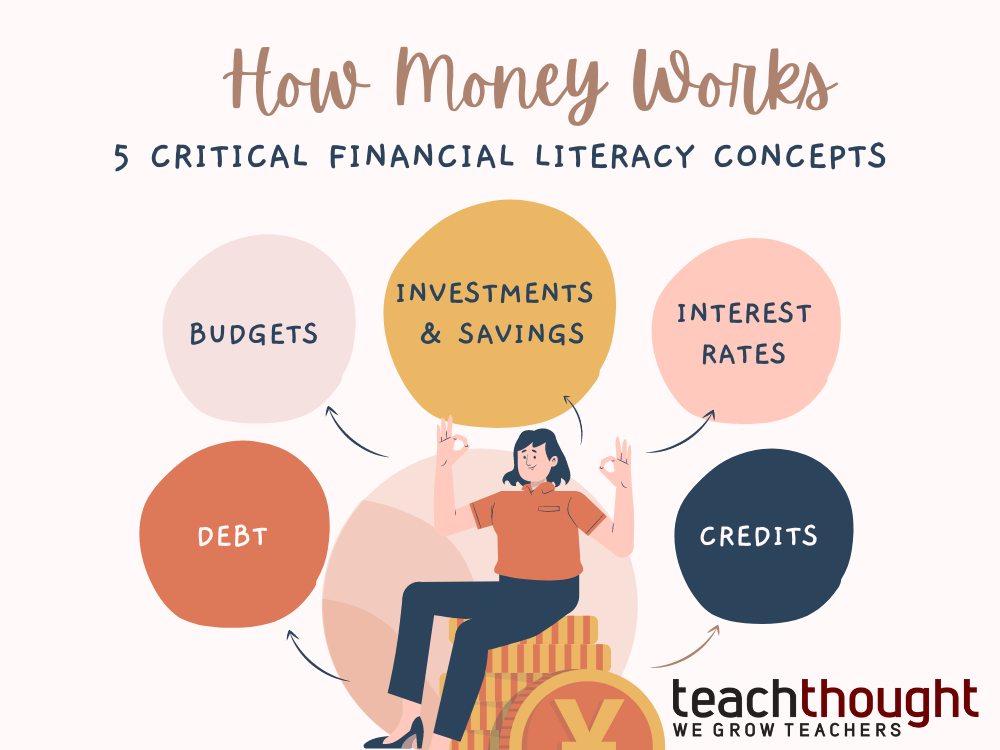
Teaching Financial Literacy: 5 Critical Concepts About How Money Works
contributed by Karla Lopez
The young people today face a staggering number of elaborate financial decisions.
One problem is that most of them are not ready to make well-informed financial decisions as they proceed into adulthood. As a matter of fact, according to the study in 2014 titled “The Financial Capability of Young Adults—A Generational View,” 3 out of 4 young adults can’t answer simple financial questions.
While helping students develop traditional academic knowledge is useful for every child’s future, teaching students about financial literacy can be the difference between a life well-lived and a constant struggle to meet the crushing demands of money.
By teaching financial literacy lessons early in a child’s cognitive development, we can motivate or inspire them to save money and empower them to be caretakers of their own financial futures. Below are five important financial literacy concepts to consider when teaching financial literacy.
Teaching Financial Literacy: 5 Critical Concepts About How Money Works
1. Debt
Critical ideas: The definition of debt; The ‘math’ of debt; assets; common debt sources; debt reduction strategies; debt traps; taxable income
It’s easier to gain debt than to eliminate it. Young people often don’t fully understand how easy accrue debt. Because of this, it is essential to conduct lessons about debt earlier than later. Moreover, common personal debt sources are credit card debt and student loans.
2. Budgets
Critical ideas: The definition of ‘budget’; priorities; needs vs wants; budget examples and templates; budget strategies and goals; budghet apps, resources, and tips
One of the essential aspects of staying completely in control of your finances is by building and sustaining a budget. Nowadays, it is much easier than ever to make a budget through the aid of several apps and websites–Mint.com, for example.
Many of these user-friendly tools have important data and calculations embedded within them, as well as useful visualizations of how money is being saved and spent. With such tools, anyone can keep their finances on track if they’re living within their means.
When used correctly, they will keep you up to date about where your money is going. No matter how great the software is, if you don’t actually follow the budget, it won’t help. Therefore, any financial novice should begin mastering the basics of principles of budgeting.
3. Investments and Savings
Critical ideas: Account types, IRAs, 401ks, taxes, stocks, bonds, CDs
Clearly, saving is an important aspect of any kind of grasp of financial literacy. However, most of the young people do not prioritize or treat this aspect as necessary as much as they should. It can be easy to neglect things like retirement because it lacks the immediacy of everyday life. It can be difficult to ‘worry’ about something that won’t happen for half-a-century or more. However, learning to save money early can aid you in gaining a set of discipline, skills, and knowledge you will use in your life.
Financial novices can begin saving in the simplest sense–saving money for clothes, technology, books, or concerts they desire, for example. While developing their ‘saving skills,’ students can also develop qualities like patience and diligence which–for most students–only grow through practice.
4. Interest Rates
Critical ideas: Compound interest, amortization, relationship to credit score, loan types
Although students have likely heard about interest rates in math class, it is very critical to learn various aspects such as ratios, percentages, and compound interest. These financial literacy concepts can help students in very practical ways–learning about the difference between borrowing money and repaying with interest and fees, for example.
Understanding interest rates can influence finances more than most realize and is a simple but powerful concept to learn.
5. Credit
Critical ideas: Credit scores, interest rates, annual fees, rations (e.g., debt-to-income), identity theft, deferment
The concept of credit–the ability of practice of asking for money that you don’t have because it’s believed you’ll pay it back at some point–is a concept deeply-embedded in Western culture. This has many drawbacks, including how thoughtlessly it is practiced as a result. For many, it’s just accepted that you’ll spend a lifetime borrowing other people’s money and that, rather than making it yourself, it’s better to constant groom your own financial identity so that your believability and ‘creditworthiness’ are improved. This is a hurtful belief that can cause students to spend a lifetime struggling with ‘money’ when in reality, the issue is how they think about money.
Further, with the explosion of credit and lending, identity theft is more widespread and common than ever. Because almost everything is digital and most people shops online, student financial info is at great risk and keeping accounts safe is a daily practice through preemptive measures such as limiting the amount of info shared online, encryption, and password protection.
Other important financial literacy ideas: The economy (e.g., how it works, federal rates, trends and markets, etc.); different financial account types; wages and income types; cryptocurrencies
Conclusion
Financial literacy is essential as it prepares students with the right skills, habits, and knowledge they need to stay on top of our finances effectively. Without it, their financial decisions can lack a robust foundation for success. There’s a lot that goes into financial literacy–so much so that it there are entire industries, academic fields, and institutions tied to economic and financial support.
However, these five concepts above can be useful as a head-start in supporting students as they develop ‘life skills’ to, matched with their academics, learn to live well.
